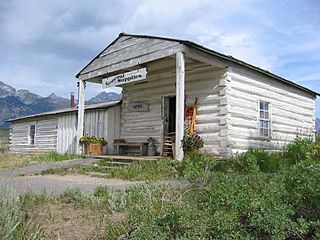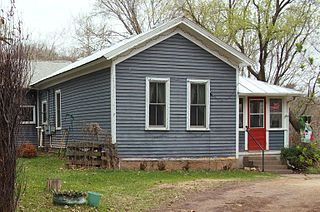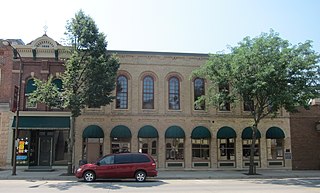
Stillwater is a city in, and the county seat of, Payne County, Oklahoma, United States. It is located in north-central Oklahoma at the intersection of U.S. Route 177 and State Highway 51. As of the 2010 census, the city population was 45,688, making it the tenth-largest city in Oklahoma. The Stillwater Micropolitan Statistical Area had a population of 78,399 according to the 2012 census estimate. Stillwater was part of the first Oklahoma Land Run held on April 22, 1889 when the Unassigned Lands were opened for settlement and became the core of the new Oklahoma Territory. The city charter was adopted on August 24, 1889, and operates under a council-manager government system.

Murray is a city situated on the Wasatch Front in the core of Salt Lake Valley in the U.S. state of Utah. Named for territorial governor Eli Murray, it is the state's fourteenth largest city. According to the 2010 census, Murray has approximately 46,746 residents. Murray shares borders with Taylorsville, Holladay, South Salt Lake and West Jordan, Utah. Once teeming with heavy industry, Murray's industrial sector now has little trace and has been replaced by major mercantile sectors. Known for its central location in Salt Lake County, Murray has been called the Hub of Salt Lake County. Unlike most of its neighboring communities, Murray operates its own police, fire, power, water, library, and parks and recreation departments and has its own school district. While maintaining many of its own services, Murray has one of the lowest city tax rates in the state.

Chana School is a Registered Historic Place in Ogle County, Illinois, in the county seat of Oregon, Illinois. One of six Oregon sites listed on the Register, the school is an oddly shaped, two-room schoolhouse which has been moved from its original location. Chana School joined the Register in 2005 as an education museum.

The Thomas Select School is a historic log building in rural Butler County, Ohio, United States. Constructed in 1810, the building has seen numerous uses, ranging from church to school to house. It has been named a historic site.

The Virginia Park Historic District is located on the north side of New Center, an area in Detroit, Michigan, along both sides of Virginia Park Street from Woodward Avenue to the John C. Lodge Freeway access road. The district was listed on the National Register of Historic Places in 1982.

Willamette Mission State Park is a state park in the U.S. state of Oregon, located about four miles (6 km) north of Keizer adjacent to the Wheatland Ferry and east of the Willamette River. It includes Willamette Station Site, Methodist Mission in Oregon, which is listed by the National Register of Historic Places.

Menor's Ferry was a river ferry that crossed the Snake River near the present-day Moose, Wyoming, United States. The site was homesteaded by Bill Menor in 1892-94, choosing a location where the river flowed in a single channel, rather than the braided stream that characterizes its course in most of Jackson Hole. During the 1890s it was the only homestead west of the river. Menor's homestead included a five-room cabin, a barn, a store, sheds and an icehouse on 148 acres (60 ha), irrigated by a ditch from Cottonwood Creek and at times supplemented by water raised from the Snake River by a waterwheel. Menor operated the ferry until 1918, selling to Maude Noble, who continued operations until 1927, when a bridge was built at Moose.

The Henry J. Wheeler Farm is a farmstead in Murray, Utah, United States, that one of the few remaining late 19th century farmsteads in the Salt Lake Valley that have not been lost to expanding housing developments of metropolitan Salt Lake City. It was listed on the National Register of Historical Places since 1976.\

The Murray Downtown Residential Historic District is the best representative area of the residential settlement and development of the city of Murray, Utah, United States. It was listed on the National Register of Historic Places in 2005. It is locally significant as a physical reflection of its residential architecture and the historic development of the city from its agricultural beginnings through its industrial era and current status as a small suburban city. The buildings within the district represent the wide range of architectural styles and plans popular in the city and the state of Utah between 1870 and 1954 and retain a high degree of integrity.

The Glenville School is a historic school building at 449 Pemberwick Road in the Glenville section of Greenwich, Connecticut, United States. It was listed on the National Register of Historic Places in 2003. It was one of several schools built in the town in the 1920s, when it consolidated its former rural school districts into a modern school system, with modern buildings.

The Upper Brownlee School is a historic school building located on Dry Buck Road near Sweet, Idaho, United States. The school was built in 1911 by the residents of Brownlee, one of the several small mining communities which had grown in the Boise River basin in the late 19th century. The two-room schoolhouse was built in keeping with contemporary standards for rural schools; it provided for heating and ventilation, had several windows to provide light, included two cloakrooms and a library room, and featured hand-carved wooden trim for decoration. Like many rural Idaho schools, the schoolhouse also served as the local community center. The declining local population and the expense of new safety regulations in the 1940s spelled the end of Brownlee's school, and the district merged into Sweet's district in 1951. The building was purchased by area residents to serve as a community center and is now the only active community building in the area.

The Cottonwood County Courthouse is the seat of government for Cottonwood County, Minnesota, United States, located in the city of Windom. It has been in continual use since its dedication in 1905. It was listed on the National Register of Historic Places in 1977 for its state-level significance in the themes of architecture and art. It was nominated for the neoclassicism expressed throughout the building, from the exterior architecture to the interior design and artwork.

The UVX Mining Co., owned by James S. Douglas, Jr., operated the United Verde Extension (UVX) Mine at Jerome and built a copper smelter complex at Clemenceau (Cottonwood) in the U.S. state of Arizona. The complex, operational from 1917 through 1937, is listed on the National Register of Historic Places.

Black Forest School or Old Log School of Black Forest is a historic school in Black Forest, Colorado. It is a National Register of Historic Places listing and is one of the schools on a multiple submission of "Rural School Buildings in Colorado" for the Colorado State Register of Historic Properties.

The Governor Brann School is a historic school building on United States Route 1 in Cyr Plantation, Maine. It presently is used by the plantation as a polling station and meeting place. The school was named for Louis J. Brann, who was Governor of Maine at the time of its construction in 1934. It is the best-preserved of the community's former district school buildings; it was listed on the National Register of Historic Places in 1993.

The Pest House in Stillwater Township, Minnesota, United States, is a former quarantine facility used by the city of Stillwater circa 1872 to 1910. It is a rare surviving example of a pest house, a common public health strategy of the late 19th and early 20th centuries, where people with contagious diseases were isolated. It was listed on the National Register of Historic Places in 1980 for having local significance in the theme of health/medicine. The original three-room Pest House has been converted into a private residence, with the addition of a porch on the southeast and a rear wing to the northwest.

Flanders' Block is a historic commercial building in Madelia, Minnesota, United States, built in 1872. From 1872 to 1878 it served as the county seat building of Watonwan County, housing the courthouse, offices, and jail. Flanders' Block was listed on the National Register of Historic Places in 1984 for having local significance in the theme of politics/government. It was nominated for its associations with the early development of Watonwan County's government.

Mill Rock School is a historic one-room schoolhouse located south of Baldwin, Iowa, United States. It is one of over 217 limestone structures in Jackson County from the mid-19th century, of which 12 are school buildings. This school building was built in 1869 by Abner Hunt and P.A. Downer. The stone blocks that were used in the construction of this rectangular structure vary somewhat in shape and size, and they were laid in courses. The window sills and lintels are dressed stone. There is a brick chimney on the west elevation, and two entrance doors on the east elevation. Having two entrance doors is unusual for rural Jackson County schools. A name and date stone is located in the east gable.

A two-room schoolhouse is a larger version of the one-room schoolhouse, with many of the same characteristics, providing the facility for primary and secondary education in a small community. While providing the same function as a contemporary primary school or secondary school building, a small multi-room school house is more similar to a one-room schoolhouse, both being architecturally very simple structures. While once very common in rural areas of many countries, one and two-room schools have largely been replaced although some are still operating. Having a second classroom allowed for two teachers to operate at the school, serving a larger number of schoolchildren and/or more grade levels. Architecturally, they could be slightly more complex, but were still usually very simple. In some areas, a two-room school indicated the village or town was wealthier and more prosperous.























